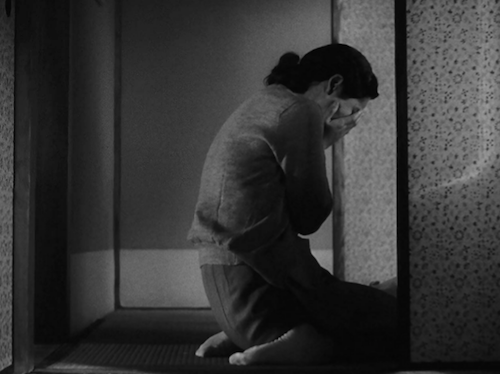
Tokyo Twilight follows the parallel paths of two sisters contending with an absent mother, unwanted pregnancy, and marital discord.
“Some of Ozu’s most striking compositions grace Tokyo Twilight, whose dusky title suggests sadness, transience, ambiguity - appropriate for this tale of a family’s downfall. Setsuko Hara is magnificent as a woman who leaves her abusive, alcoholic husband and returns home to her father and younger sister. The latter, pregnant and abandoned by her boyfriend, undergoes an abortion before both sisters discover a family secret that has devastating consequences. Set in a Tokyo quarter of pachinko and mahjong parlors, rundown bars, and noodle shops in the gray chill of midwinter, Tokyo Twilight seems more histrionic than many Ozu dramas. Yet the low-slung camera shots, straight cuts, and severely delimited space, the marvelously detailed soundtrack and distinctive music, combine to make the film classically Ozu.”
Harvard Film Archive1
“Although the renewal promised by the changing of the seasons in his other films is notably absent here, Ozu was nonetheless using Tokyo Twilight as a vehicle to change perceptions. Prior to its release, he claimed that “the true flavour of the home drama will be found in this film.” Paradoxically, Tokyo Twilight is arguably one of Ozu’s most restless films, wherein the familiarity of domestic scenes is replaced by the desperately itinerant movements of Akiko as she attempts to find her errant boyfriend, Kenji, in Tokyo’s mahjong parlours, noodle shops, laneway bars and late-night cafés. This view of the city is one in which the characters wear face masks as protection from its contamination, men are arrested for stealing women’s underwear and anti-prostitution laws are enacted. The setting of a ‘home drama’ predominantly within the seedy textures of Tokyo’s industrial topography can be interpreted as Ozu’s comment on the fracturing of the Japanese family in the aftermath of the Second World War.”
Danica van de Velde2
“Tokyo Twilight resurfaces at a time when the lasting effects of a family’s breakup upon children are being addressed more forthrightly than ever before. Ozu cherishes tradition but accepts the inevitability of loss and change, and is as all-embracing as Jean Renoir. His people may judge and not forgive, often understandably, but as one of the greatest filmmakers he does not do so. He even has faith that children have the capacity to learn from their parents’ mistakes and not repeat them.”
Kevin Thomas3
“Ozu allowed himself three shots: the long shot, the middle shot, and the semi-close-up. [...] The close-up is used for intimate moments. But Ozu never allows the camera to come too close. One reason for this is that the low camera angle would never allow it. A more fundamental reason is that Ozu would not allow the camera to evoke emotion. All emotion in an Ozu film comes from the characters, and any feeling of emotion which might come by using a “big” close-up is as much cheating as any other artificial camera technique.”
Marvin Zeman4
“One of the means by which Ozu truimphs over these actual or potential limitations is his highly personal style, which puts the action in perspective in the most direct and immediate way possible: by keeping the spectator at a distance from it so that he is free to contemplate it with some detachement. [...] Ozu presents us with nothing that is irrelevant, or merely decorative, but on the other hand, he never seeks for emotional effect by dramatising, by any for of speeding-up, increasing tension, “heightening” by means of emphasis (in either acting of camera-work), that does not arise quite naturally from the human context.”
Robin Wood5
- 1Harvard Film Archive
- 2Danica van de Velde, “Tender Restraint: Tokyo Twilight (Yasujirô Ozu, 1957),” Senses of Cinema, 2019, nr. 90 (2019).
- 3Kevin Thomas, “Ozu’s rare take on ‘Tokyo Twilight’,” Los Angeles Times (2007).
- 4Marvin Zeman, “The Serene Poet of Japanese Cinema: The Zen Artistry of Yasujiro Ozu,” The Film Journal vol. 1, 1972, nr. 3-4 (1972).
- 5Robin Wood, “Tokyo Story,” Movie, 1965, nr. 13 (1965).

